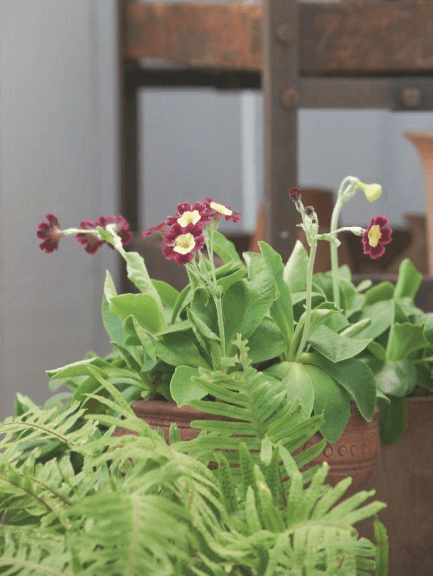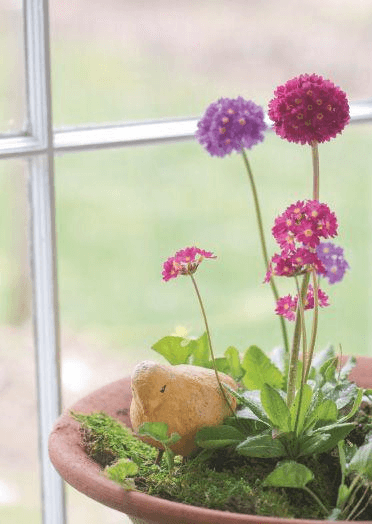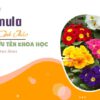[Ebook Việt hóa] The Unexpected Houseplant: 220 Extraordinary Choices for Every Spot in Your Home, Chi Primula - Chi Anh Thảo
[Ebook Việt Hoá] The Unexpected Houseplant: Primulas (chi Primula, chi Anh Thảo)
- Nguồn: [Ebook] The Unexpected Houseplant: 220 Extraordinary Choices for Every Spot in Your Home –
- Biên tập: Dũng Cá Xinh (Tháng 02/2022)
- Dịch: Team Codai.net
English
PRIMULAS
THE ‘FLAMING PURISSIMA’ tulips have joined my magnolia out front to make the view from my office window absolutely breathtaking. Granted, it’s tough to confine my concentration indoors. But that’s where I work until 5 p.m., when they unlock the chains that hitch me to the computer. Fortunately, Primula × pubescens is sitting by my side in full flower to sweeten the time at my desk.

Without the auricula hybrids (and Primula × pubescens is Primula auricula × Primula hirsuta), life would be dull and lackluster through winter and early spring. Even with all my other houseplants, the auricula hybrids are paramount. And for good reason: small clusters of nickel-size flowers open in improbable shades of cranberry, deep purple, wine red, and mauve running in bands. But there’s more. The center of each flower is dusted with a signature powder that gives it substance. Meanwhile, the leaves are thick, leathery, and also powdered with stardust. The fancy, named-variety, green-or gray-flowered exhibition auriculas are far too pricey and finicky for me to grow. Nevertheless, my versions are sufficiently enthralling to send me hopping up periodically to catch yet another glance at their flowers.
Dangle an auricula hybrid in my line of vision, and I’ll be waving dollar bills in response. The collection grows. In autumn, I repotted the whole crew. I gave them a rich soil mix heavy with compost and sank the rosettes into the soil (with time, they tend to push their shoulders up and out). I didn’t graduate each plant into a larger container; instead, I shook away their soil and gave them fresh underpinnings. Then I bestowed the gang with prime seating in a west window throughout autumn and early winter. They did fine until the days lengthened, and then the wilting began. So I sprinted into action and moved the whole flock into a spot in the greenhouse that gets no direct sun. They expressed gratitude. Although auricula hybrids certainly don’t need a greenhouse, they like the ambient indirect light. They’ve been blooming for several months now and coloring my life. A bunch of Easter eggs couldn’t do a better job.

This has been going on for a few years. The auricula hybrid primroses are part of the permanent cast in the house. But they’re joined by a chorus of spring-blooming primroses that perform for my edification indoors and then add their voice permanently (I hope) to the primrose garden under the black walnut outside. Who can resist Primula denticulata, the precocious drumstick primrose? Not only does the duration of their glory start earlier and last longer inside, but their little round drumsticks aren’t splattered by the constant mud that kicks up in spring showers. Equally fab is the parrot-green-flowered P. vulgaris ‘Francesca’. When it first hit the scene, I couldn’t resist adding it to the compendium inside. Like its kin, ‘Francesca’ was a raving success.
The open-door policy doesn’t extend throughout the entire clan. I go only for spring bloomers, knowing the house will be too warm over the summer. I steer away from the whitefly-attracting (and dermatologically irritating) Primula obconica. Similar troublemakers are the ordinary British primroses, Primula × polyantha (the primroses you find in the supermarket with little nosegays of brightly colored blossoms nestled into a rosette of leaves), now classifying as Pruhonicensis hybrids. They cause no skin angst, but get spider mites, whiteflies, and aphids. Plus, they always seem to be wilted—even in a shady spot. Who needs that?
If you want to try primroses, here’s the secret: use indirect light and never let them wilt. And by all means, whisk them outside when they finish blossoming. Outdoors, they give additional years of pleasure. It’s the best of all worlds.
| FLOWERS | Colorful flowers held above the foliage |
| FOLIAGE | Rosettes of leaves, silverish gray for the auricula hybrids, green and deeply veined for the drumsticks |
| OTHER ATTRIBUTES |
Hardy outdoors; plant them in the garden when they finish flowering |
| SIZE | Under 6 inches (15cm) in height |
| EXPOSURE | Diffuse east or west |
| WATER REQUIREMENTS |
Keep evenly moist but not drenching wet |
| OPTIMUM NIGHTTIME TEMPERATURE |
50–55°F (10–12°C) |
| RATE OF GROWTH | Slow |
| SOIL TYPE | Good organic potting soil mix with compost included |
| FERTILIZING | I give the auriculas fish emulsion in late winter and spring; I don’t fertilize the other primulas |
| PROBLEMS | Mealy bugs can be a pressing issue, but only occur when growing conditions aren’t ideal. Aphids, whiteflies, and spider mites occur on the other primulas. Some primulas can cause a dermatological reaction. |
Tiếng Việt
CHI ANH THẢO
Hoa tulip ‘FLAMING PURISSIMA’ đã kết hợp với cây mộc lan của tôi ở phía trước để làm cho khung cảnh từ cửa sổ văn phòng của tôi trở nên hoàn toàn ngoạn mục. Đúng vậy, thật khó để hạn chế sự tập trung của tôi trong nhà. Nhưng đó là nơi tôi làm việc cho đến 5 giờ chiều, khi họ mở khóa dây xích buộc tôi vào máy tính. May mắn thay, hoa Anh thảo đang ngồi bên cạnh tôi đầy hoa để làm dịu thời gian trên bàn làm việc của tôi.

Nếu không có các giống lai auricula (và Primula × pubescens là Primula auricula × Primula hirsuta), cuộc sống sẽ thật buồn tẻ và mờ nhạt trong suốt mùa đông và đầu mùa xuân. Ngay cả với tất cả các giống cây trồng trong nhà khác của tôi, các giống lai auricula là điều tối quan trọng. Và vì lý do chính đáng: các cụm hoa nhỏ cỡ niken mở ra với các sắc thái không thể nhầm lẫn của việt quất, tím đậm, đỏ rượu vang và hoa cà chạy thành từng dải. Nhưng còn nhiều hơn thế nữa. Trung tâm của mỗi bông hoa được phủ một lớp bột đặc trưng tạo nên chất riêng cho nó. Trong khi đó, lá dày, nhiều da và cũng có bột với stardust. Những cánh đồng triển lãm có hoa màu xanh lá cây hoặc xám lạ mắt, đa dạng được đặt tên là quá đắt và quá khó để tôi có thể phát triển. Tuy nhiên, các phiên bản của tôi đủ say mê để gửi tôi đến định kỳ để ngắm nhìn những bông hoa của chúng.
Đặt một con lai auricula trong tầm nhìn của tôi và tôi sẽ vẫy những tờ đô la để đáp lại. Bộ sưu tập phát triển. Vào mùa thu, tôi thay chậu cho cả đoàn. Tôi cho chúng một hỗn hợp đất giàu có trộn với phân trộn và thả hoa thị vào đất (theo thời gian, chúng có xu hướng đẩy vai lên và ra ngoài). Tôi đã không chuyển từng cây vào một thùng chứa lớn hơn; thay vào đó, tôi rũ bỏ đất của chúng và cho chúng những lớp nền mới. Sau đó, tôi đã ban cho băng nhóm một chỗ ngồi chính ở một cửa sổ phía tây trong suốt mùa thu và đầu mùa đông. Họ đã làm tốt cho đến khi ngày dài kéo dài, và sau đó sự héo úa bắt đầu. Vì vậy, tôi lao vào hành động và di chuyển cả đàn vào một chỗ trong nhà kính không có ánh nắng trực tiếp. Chúng bày tỏ lòng biết ơn. Mặc dù các giống lai auricula chắc chắn không cần nhà kính nhưng chúng thích ánh sáng gián tiếp xung quanh. Chúng đã nở rộ trong vài tháng nay và tô màu cho cuộc sống của tôi. Một loạt trứng Phục sinh không thể làm tốt hơn.

Điều này đã diễn ra trong một vài năm. Các loài Anh thảo lai auricula là một phần của các loài thường trú trong nhà. Nhưng chúng được tham gia bởi một dàn đồng ca gồm các loài hoa Anh thảo nở rộ vào mùa xuân biểu diễn cho sự gây dựng của tôi trong nhà và sau đó thêm giọng của chúng vĩnh viễn (tôi hy vọng) vào khu vườn hoa anh thảo dưới cây óc chó đen bên ngoài. Điều gì có thể chống lại Primula denticulata, loài hoa anh thảo phát triển rễ rất sớm? Thời gian vinh quang của chúng không chỉ bắt đầu sớm hơn và kéo dài bên trong, mà những rễ tròn nhỏ của họ cũng không bị bắn tung tóe bởi lớp bùn liên tục bốc lên trong những cơn mưa rào mùa xuân. Tương tự như loài vẹt có hoa màu xanh lá cây là P. vulgaris ‘Francesca’. Khi nó xuất hiện lần đầu tiên, tôi không thể cưỡng lại việc thêm nó vào bản tóm tắt bên trong. Giống như người thân của nó, ‘Francesca’ là một thành công vang dội.
Chính sách mở cửa không áp dụng trong toàn bộ giống. Tôi chỉ đi đến những người có hoa nở vào mùa xuân, vì biết rằng ngôi nhà sẽ quá ấm vào mùa hè. Tôi tránh xa loài Primula obconica thu hút ruồi trắng (và gây kích ứng da liễu). Những kẻ gây rối tương tự là chi Anh thảo bình thường của Anh, Primula × polyantha (chi Anh thảo bạn tìm thấy trong siêu thị với những bông hoa màu rực rỡ nằm gọn trong một chùm lá), hiện được phân loại là Pruhonicensis hybrid. Chúng không gây đau rát da, nhưng lại bị ve nhện, ruồi trắng và rệp. Thêm vào đó, chúng dường như luôn bị héo úa – ngay cả khi ở một nơi râm mát. Ai cần cái đó?
Nếu bạn muốn thử các chi Anh thảo, đây là bí quyết: sử dụng ánh sáng gián tiếp và không bao giờ để chúng héo. Và bằng mọi cách, đánh bông chúng bên ngoài khi chúng nở hoa xong. Ngoài trời, chúng mang lại cho bạn nhiều năm thú vị. Đó là điều tốt nhất trong tất cả các thế giới..
| HOA | Những bông hoa đầy màu sắc được mọc trên những tán lá |
| TÁN LÁ | Hoa hồng của lá, màu xám bạc đối với các giống lai auricula, màu xanh lá cây và có gân sâu đối với rễ |
| THUỘC TÍNH KHÁC | Khó ở ngoài trời; trồng chúng trong vườn khi chúng kết thúc ra hoa |
| KÍCH THƯỚC | Chiều cao dưới 6 inch (15 cm) |
| HƯỚNG | Khuếch tán đông hoặc tây |
| YÊU CẦU VỀ NƯỚC | Giữ ẩm đều nhưng không làm ướt đẫm |
| NHIỆT ĐỘ ĐÊM TỐI ƯU | 50–55°F (10–12°C) |
| TỶ LỆ TĂNG TRƯỞNG | Chậm |
| LOẠI ĐẤT | Hỗn hợp đất bầu hữu cơ tốt với phân trộn bao gồm |
| PHÂN BÓN | Cung cấp phân bón nhũ cá cho auriculas vào cuối mùa đông và mùa xuân; Không bón phân cho những loài khác |
| CÁC VẤN ĐỀ | Rệp sáp có thể là một vấn đề cấp bách, nhưng chỉ xảy ra khi điều kiện phát triển không lý tưởng. Rệp, ruồi trắng và bọ nhện xuất hiện trên các chi Anh thảo khác. Một số có thể gây ra phản ứng da liễu. |




